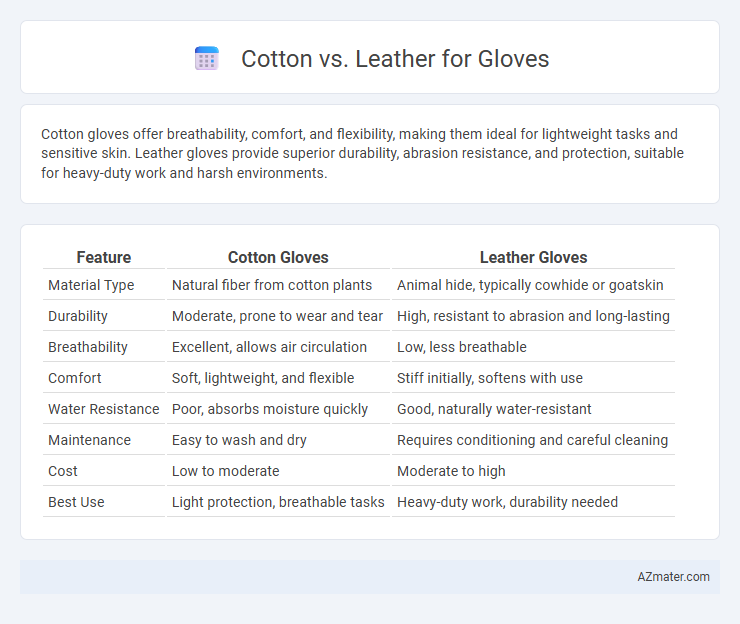Cotton gloves offer breathability, comfort, and flexibility, making them ideal for lightweight tasks and sensitive skin. Leather gloves provide superior durability, abrasion resistance, and protection, suitable for heavy-duty work and harsh environments.
Table of Comparison
| Feature | Cotton Gloves | Leather Gloves |
|---|---|---|
| Material Type | Natural fiber from cotton plants | Animal hide, typically cowhide or goatskin |
| Durability | Moderate, prone to wear and tear | High, resistant to abrasion and long-lasting |
| Breathability | Excellent, allows air circulation | Low, less breathable |
| Comfort | Soft, lightweight, and flexible | Stiff initially, softens with use |
| Water Resistance | Poor, absorbs moisture quickly | Good, naturally water-resistant |
| Maintenance | Easy to wash and dry | Requires conditioning and careful cleaning |
| Cost | Low to moderate | Moderate to high |
| Best Use | Light protection, breathable tasks | Heavy-duty work, durability needed |
Introduction: Cotton vs Leather Gloves
Cotton gloves offer breathability, lightweight comfort, and flexibility ideal for light-duty tasks and sensitive skin, while leather gloves provide superior durability, abrasion resistance, and protection in heavy-duty applications. Cotton excels in moisture absorption and temperature regulation, making it suitable for indoor or warm environments, whereas leather's robustness and insulating properties idealize it for rugged outdoor work and cold conditions. Choosing between cotton and leather gloves depends on balancing comfort, protection level, and task requirements.
Material Composition and Source
Cotton gloves are made from natural fibers harvested from the cotton plant, prized for breathability and softness, while leather gloves are crafted from the tanned hides of animals such as cows, goats, or pigs, valued for durability and protection. Cotton fibers consist primarily of cellulose, offering lightweight and moisture-absorbing properties, whereas leather's composition includes collagen fibers, providing strength and flexibility. The renewable plant-based origin of cotton contrasts with the animal-derived sourcing of leather, impacting sustainability and ethical considerations in glove production.
Comfort and Fit Comparison
Cotton gloves offer superior breathability and softness, making them ideal for comfort during extended wear by reducing moisture buildup and skin irritation. Leather gloves provide a snugger fit with better durability and flexibility, molding to hand contours for enhanced dexterity and protection. The choice between cotton and leather hinges on prioritizing lightweight comfort versus a secure, form-fitting glove optimized for manual tasks.
Durability and Longevity
Leather gloves offer superior durability and longevity compared to cotton gloves due to their natural toughness and resistance to wear and tear. High-quality leather, such as cowhide or goatskin, can withstand heavy use, abrasion, and moisture exposure, making it ideal for industrial, gardening, or motorcycle gloves. Cotton gloves, while breathable and lightweight, tend to wear out faster and lose shape or strength after frequent washing and prolonged use.
Breathability and Moisture Management
Cotton gloves offer superior breathability due to their natural fibers, allowing air to circulate and reducing sweat buildup during prolonged use. Leather gloves provide moderate breathability but excel in moisture resistance, often featuring treatments that repel water while maintaining durability. For optimal moisture management, cotton excels in wicking away sweat for comfort, whereas leather's dense structure limits moisture penetration, making it better suited for wet conditions.
Protection and Safety Features
Leather gloves offer superior protection and durability compared to cotton gloves, providing enhanced resistance against cuts, abrasions, and punctures, making them ideal for heavy-duty tasks and industrial use. Cotton gloves prioritize comfort and breathability but lack the robust safety features necessary for high-risk environments, offering minimal protection against sharp objects or heat. For workers requiring reliable safety gear, leather gloves are the optimal choice due to their strength, impact resistance, and better grip in hazardous conditions.
Flexibility and Dexterity
Cotton gloves offer superior flexibility and breathability, making them ideal for tasks requiring fine motor skills and prolonged wear without discomfort. Leather gloves provide enhanced durability and protection but tend to be stiffer, which can slightly reduce dexterity compared to cotton. For precision work, cotton gloves typically allow greater finger movement and tactile sensitivity, while leather gloves balance protection with moderate flexibility.
Maintenance and Cleaning Requirements
Cotton gloves require frequent washing to maintain hygiene and are machine washable, but they may shrink or lose shape if not handled properly. Leather gloves demand specialized cleaning with products like leather conditioners and should be wiped down rather than submerged in water to preserve their texture and durability. Proper maintenance extends the lifespan of leather gloves, while cotton gloves offer easier but more frequent cleaning needs.
Cost and Value Considerations
Cotton gloves are generally more affordable, offering basic protection and breathability ideal for light-duty tasks, while leather gloves command a higher price due to durability and enhanced protection against abrasions and heat. The long-term value of leather gloves lies in their longevity and resistance to wear, making them cost-effective over extended use despite the initial investment. Cost considerations hinge on the frequency and intensity of glove use, where cotton suits budget-conscious buyers with minimal protection needs, and leather appeals to those requiring robust performance and durability.
Best Use Cases: Choosing the Right Glove
Cotton gloves offer lightweight breathability and comfort, making them ideal for light-duty tasks like assembly, inspection, and general handling where dexterity is key. Leather gloves provide superior durability, abrasion resistance, and protection, suited for heavy-duty activities such as construction, welding, and outdoor work. Selecting the right glove depends on task requirements, prioritizing cotton for finesse and leather for robust protection.

Infographic: Cotton vs Leather for Glove
 azmater.com
azmater.com